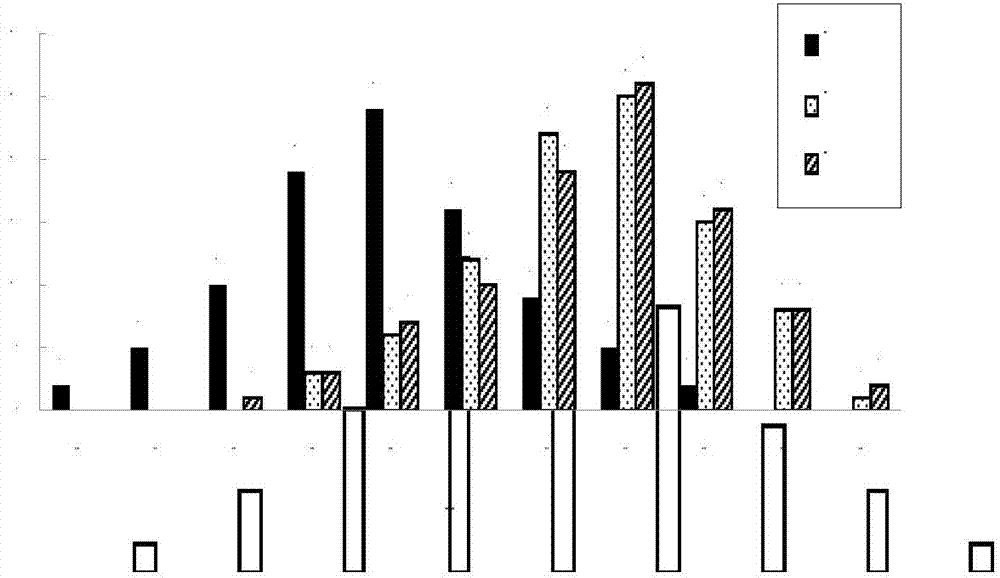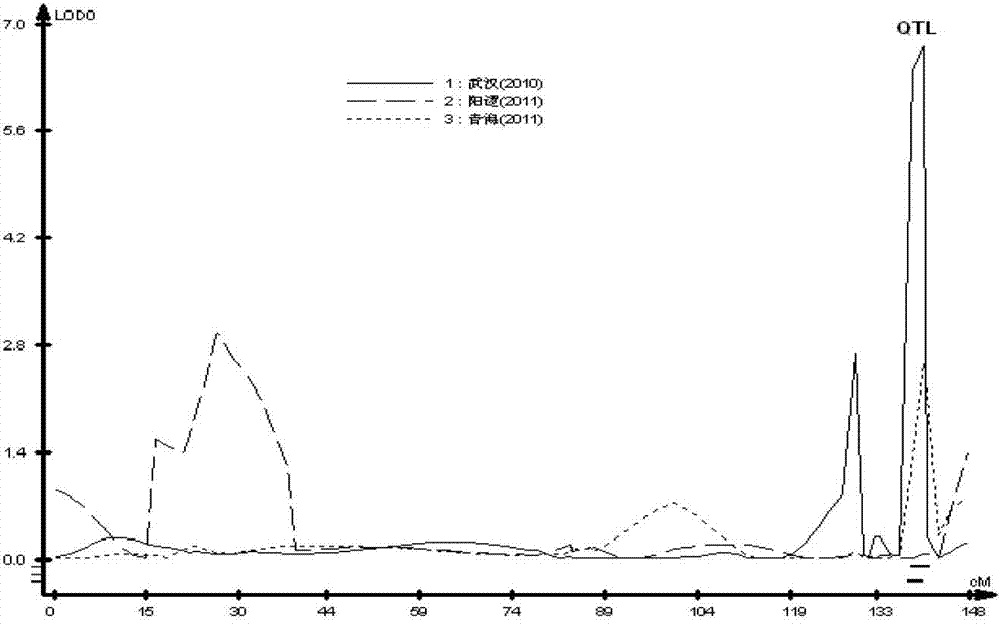Molecular marker closely linked with oil content character of rapes and application
A technology of molecular markers and oil content, applied in the field of molecular biology and genetic breeding, can solve the problems of small effect value, poor repeatability, difficult application of rapeseed breeding, etc., and achieve the effect of high difficulty, clear selection target and high cost
- Summary
- Abstract
- Description
- Claims
- Application Information
AI Technical Summary
Problems solved by technology
Method used
Image
Examples
Embodiment 1
[0031] Example 1. Construction and Character Measurement of Rapeseed Oil Content Separation Population
[0032] The population used in this example is the offspring of hybrids of high and low oil content parents (zy036 with oil content of 50% and 51070 with 36% respectively)—DH population. DH isolates were harvested in Wuhan in 2010, Yangluo and Qinghai in 2011, respectively. Seed oil content of parents and DH populations was determined by near-infrared analyzer. The distribution results of oil content data show that the oil content of the three experiments are all in continuous normal distribution, and the variation range is very wide, which proves that the oil content is a quantitative trait ( figure 1 ).
Embodiment 2
[0033] Example 2. Extraction of total DNA from leaves of parental zy036, 51070 and DH segregation populations
[0034] The total DNA of leaves was extracted by the CTAB method, and the specific steps were as follows:
[0035] A. Take 0.1 gram of fresh leaves and grind them, add 700 microliters of extract to grind them, then put them in a 1.5 milliliter centrifuge tube and place them in a constant temperature water bath at 65°C for 60 minutes, during which they mix 2-3 times;
[0036] B. Add an equal volume of phenol: chloroform: isoamyl alcohol (25:24:1, volume ratio), gently invert to mix well; centrifuge at 12000rpm for 10 minutes to make layers, gently suck the supernatant into another 1.5 ml centrifuge tube; add an equal volume of chloroform: isoamyl alcohol (24:1, volume ratio) and re-extract once;
[0037] C. Add 1 ml of -20°C pre-cooled absolute ethanol, freeze at -20°C for no more than 30 minutes to precipitate DNA; centrifuge at 12,000 rpm for 10 minutes, pour off...
Embodiment 3
[0039] Example 3. Development of primers and screening of polymorphisms
[0040] The primers used by the applicant include three categories: the first category is the simple repeat sequence (SSR) primer sequence published in published articles and Brassica database (http: / / www.brassica.info / resource / markers / ssr-exchange .php), including BN, BnEMS, BnGMS, BoGMS, BrGMS, BRAS, CB, CNU, EJU, ENA, FITO, IGF, MR, Na, Ni, Ol, Ra, niab, sN, sR and sS and many other series; The second category is that the applicant uses MISA software to search for SSR sites in the whole genome sequence of Chinese cabbage, Brassica oleracea and Brassica napus based on the sequencing results of Chinese cabbage, Brassica oleracea and Brassica napus, and develop simple repeat sequence (SSR) primers. Use the SNP function of SOAP software to predict SNP sites in the whole genome sequences of Chinese cabbage, Brassica oleracea and Brassica napus, and develop single nucleotide polymorphism (SNP) primers, named...
PUM
 Login to View More
Login to View More Abstract
Description
Claims
Application Information
 Login to View More
Login to View More - R&D
- Intellectual Property
- Life Sciences
- Materials
- Tech Scout
- Unparalleled Data Quality
- Higher Quality Content
- 60% Fewer Hallucinations
Browse by: Latest US Patents, China's latest patents, Technical Efficacy Thesaurus, Application Domain, Technology Topic, Popular Technical Reports.
© 2025 PatSnap. All rights reserved.Legal|Privacy policy|Modern Slavery Act Transparency Statement|Sitemap|About US| Contact US: help@patsnap.com



